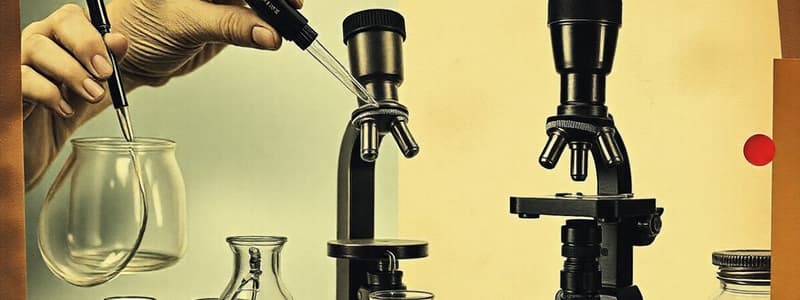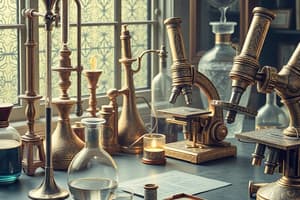Podcast
Questions and Answers
Name one piece of equipment used in the lab and explain how to use it.
Name one piece of equipment used in the lab and explain how to use it.
Serological pipette, Pasteur pipette, wet mounts on glass slide, spectrophotometer, compound microscope, Eppendorf microcentrifuge
Explain why you would use a serological pipette over a Pasteur pipette or micropipette.
Explain why you would use a serological pipette over a Pasteur pipette or micropipette.
A serological pipette is typically used when you have large volumes and need an exact measurement. You can only dispense up to 1 mL at a time when using micropipettes. While Pasteur pipettes may dispense a bit more than micropipettes, you cannot determine an exact volume dispensed.
What is the total volume in the pipette below? Explain how you were able to determine this.
What is the total volume in the pipette below? Explain how you were able to determine this.
6.8 mL. We know because the pipette reads 10 in 1/10, which indicates that the entire pipette is 10 mL. If you fill it up all the way to the top (In this case to the 10 line) and each minor tick is 0.1 mL.
If you use the 40X objective on a compound microscope to view a specimen, how would you focus the image and why? What would the total magnification be?
If you use the 40X objective on a compound microscope to view a specimen, how would you focus the image and why? What would the total magnification be?
You are conducting an experiment involving an iodine test. You place two drops of each of your samples (including a negative control) into a dry spot-plate and add the iodine solution. You wait a few minutes and you notice a positive result in your negative control. Explain an iodine test determines and how does it work? Also, explain one potential reason for having a positive result in your negative control.
You are conducting an experiment involving an iodine test. You place two drops of each of your samples (including a negative control) into a dry spot-plate and add the iodine solution. You wait a few minutes and you notice a positive result in your negative control. Explain an iodine test determines and how does it work? Also, explain one potential reason for having a positive result in your negative control.
You are given the following table with a list of solutes and their partition coefficients. If you were to place RBCs into each of these solutions and assuming they are all able to cross the RBC membrane, list the solutes in order from fastest to slowest lysis time.
You are given the following table with a list of solutes and their partition coefficients. If you were to place RBCs into each of these solutions and assuming they are all able to cross the RBC membrane, list the solutes in order from fastest to slowest lysis time.
What is the difference between independent and dependent variables? Which of these variables typically go on the x-axis? Which of these variables typically go on the y-axis?
What is the difference between independent and dependent variables? Which of these variables typically go on the x-axis? Which of these variables typically go on the y-axis?
Is this following statement a research question or hypothesis? Explain your reasoning.
Is this following statement a research question or hypothesis? Explain your reasoning.
What is the effect of temperature on the microbial growth on apples?
What is the effect of temperature on the microbial growth on apples?
In the cell membrane function and structure lab, you added RBCs to various test solutions (e.g,NaCl) and observed lysis time. Explain why you saw lysis in some solutions but not all of them
In the cell membrane function and structure lab, you added RBCs to various test solutions (e.g,NaCl) and observed lysis time. Explain why you saw lysis in some solutions but not all of them
In the cell membrane function and structure lab, you tested the lysis time at different temperatures. Explain what you used as a negative control in this experiment and why you needed a negative control.
In the cell membrane function and structure lab, you tested the lysis time at different temperatures. Explain what you used as a negative control in this experiment and why you needed a negative control.
Flashcards
Partition Coefficient
Partition Coefficient
A measurement of a solute's relative nonpolarity in a solvent.
Independent Variable
Independent Variable
The variable the experimenter changes in an experiment.
Dependent Variable
Dependent Variable
The variable that is measured in an experiment.
Research Question
Research Question
Signup and view all the flashcards
Hypothesis
Hypothesis
Signup and view all the flashcards
Serological Pipette
Serological Pipette
Signup and view all the flashcards
Micropipette
Micropipette
Signup and view all the flashcards
Compound Microscope
Compound Microscope
Signup and view all the flashcards
Iodine Test
Iodine Test
Signup and view all the flashcards
Negative Control
Negative Control
Signup and view all the flashcards
Optimum Temperature
Optimum Temperature
Signup and view all the flashcards
Study Notes
200 Question
- Question: Identify one piece of lab equipment and explain its use.
- Options include: serological pipette, Pasteur pipette, spectrophotometer, compound microscope, Eppendorf microcentrifuge.
400 Question
- Question: Explain why a serological pipette is used over a Pasteur pipette.
- A serological pipette is typically used for large volume measurements
- Micro-pipettes can only dispense up to 1ml at a time
- Serological pipettes can dispense up to 10mL
- You cannot determine the exact volume dispensed with a Pasteur pipette.
600 Question
- Question: What is the total volume in the pipette below, in mL?
- Total volume: 6.8 mL
- Reason: The pipette reads in 1/10 increments, so each minor tick is 0.1mL.
800 Question
- Question: Explain the use of 40x objective on a compound microscope.
- When focusing an image, use the fine focus only to adjust till the image is in focus.
- Coarse focus damages the slide and the lens.
- Total magnification = (magnification of objective) x (magnification of eye piece)
1000 Question
- Question: You are given a table of solutes and their partition coefficients. Order the solutes from fastest to slowest lysis time if placed in a BC membrane.
- Solute A (0.05) > Solute C (0.003) > Solute B (0.00158) > Solute D (0.00250)
- The partition coefficient is a measure of the relative nonpolarity.
- The larger the number (more nonpolar), the more quickly the lysis occurs.
Experimental Design
- Question: What is the difference between independent and dependent variables? Which of these variable(s) typically goes on the x-axis? Which of these variables typically goes on the y-axis?
- Independent variable: The thing(s) that you (as the experimenter) set in the experiment. It is a variable that you think may cause a change in a particular dependent variable.
- Dependent variable: The variable that "depends" on the independent variable; this is also the variable you are measuring.
- X-axis: independent variable, Y-axis: dependent variable
400 Reasoning
- Question: Is a statement a research question or a hypothesis? Explain reasoning.
- "What is the effect of temperature on microbial growth on apples?"
- It is a research question because a hypothesis includes predictive predictions (e.g. when I do X, Y will increase/decrease/change).
Studying That Suits You
Use AI to generate personalized quizzes and flashcards to suit your learning preferences.




